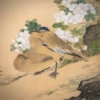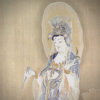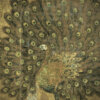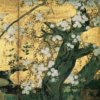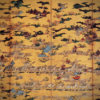Niwayama Kōen: A Maruyama-Shijō School Painter, Active in the Modern Ōsaka Art Circle
Wild Roses and a Snipe

Niwayama Kōen was born in 1870 in Himeji, Hyōgo, and moved to Ōsaka in his early childhood. He learned pictures under Ueda Kōchū, a Maruyama school painter in Ōsaka, and defended the lone base as the last painter of Maruyama school in Ōsaka. While he as a professor taught at the Naniwa Art School for a certain period, he opened the Kōen private painting school, committed to fostering younger painters. He had never belonged to any of the artist associations. While devoted to brushwork, he had spent his remaining time enjoying the creation of Bonsai, dwarfed potted trees, and collecting stamping materials. He died at the age of 74 in 1943.
Kōen was skilled at bird-and-flower paintings. It has been said that there would have been no one to compare to him when it comes to the painting of morning glories. Although Kōen’s works were reportedly favored greatly in Ōsaka, there is extremely rare nowadays to see his works. Probably forgotten as time goes by, his works may have rested in the deep inside of townhouses. In addition, many of his works had been burned out together with townhouses in the war-ravaged Ōsaka.
This painting depicts reeds at the side of a pond, wild roses with boughs stretching above the pond, and a snipe walking in the water. The reeds and wild roses are placed slightly to the left side of the upper part and the snipe placed in the lower right. Such a layout as this one depicting the snipe in the widely opened area in the lower part is extremely interesting, giving us a strong impression of a snipe gracefully taking a walk in the great nature. The exquisite composition and elaborate open space create perfect balance without the upper part of the painting too self-assertive, proving how extraordinary his painting techniques are. Though he follows the traditional style of Maruyama-Shijō school’s bird-and-flower paintings, the depiction of the reeds, the wild roses, and the snipe shows a glimpse of modern people’s rational realism. The subtle difference in the color of the wild rose’s each leaf, the dynamic depiction of the snipe with one leg up, and, more than anything else, the depiction of wild roses reflected on the surface of the water embody modern people’s realism. While he was in line with the traditional style of Maruyama-Shijō school, he had never ended up just sticking to the school’s painting techniques, unfolding a new world as a modern painter, all of which enabling Kōen to be a highly praised painter.


